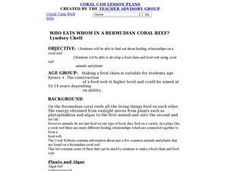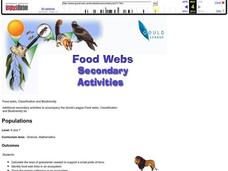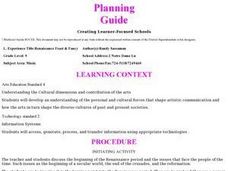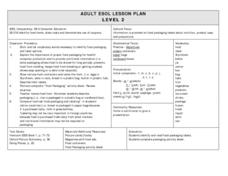Curated OER
Jelly Critters
Students compare and contrast three different organisms that are considered gelatinous zooplankton. They describe how they fit into marine food webs.
Curated OER
Banquet For the Bunch!
Students become familiar with the food guide pyramid, demonstrate a proper use of scissors and handling of glue materials, and explore the importance of eating healthy foods.
Curated OER
Who Eats Whom in a Bermudian Coral Reef?
Learners will be able to find out about feeding relationships on a coral reef. They then will be able to develop a food chain and food web using coral reef animals and plants using the Coral Website.
Curated OER
Mission Meals
Students engage in a investigation of the types of meals that astronauts eat in space while examining the types of nutritional elements needed for optimum physical tasks in space. They are given different foods and then document the...
Curated OER
Social Studies: Cameroon
Students discover the history of Cameroon and compile a list of foreign foods found in their local grocery. After taking notes on a lecture, they brainstorm a list of foods they might find on a trip to the country and compare it to what...
Curated OER
Who Ate it First?
Students complete the Seeds of Change worksheet by conducting research on the Seeds of Change website. They list foods native to the Eastern and Western hemispheres, and compile a list of recipes for a meal common after the era of...
Curated OER
Chuukese Dinner (high School)
Students read journal entries about having dinner with a Chuukese family. Using this information, they identify which foods sound appealing and compare and contrast Micronesian and American foods, fruits and vegetables. In groups, they...
Curated OER
Six Levels of Ecological Organization
Ninth graders describe the six levels of ecological organizations and give examples of each. They also differentiate between food chains and webs and identify trophic and consumer levels in food chain and food webs.
Curated OER
Food Pyramid
Second graders study nutrition and the food guide pyramid. They follow established procedures for use of programs :print in color only when directed, print only the number of copies directed by the teacher, select and use the programs...
Curated OER
There Are Algae in Your House!
Learners complete a worksheet at home stating what types of food they have at home with algae in it. They, in groups, compare with each other what they have on their worksheet.
Curated OER
Populations
Students calculate the area of grasslands needed to support a small pride of lions. They also identify food web links in an ecosystem and trace the energy pathways in an ecosystem.
Curated OER
The Macaroni Lab
Young scholars are given an introduction to the "ecosystem", what factors make up an ecosystem (biotic factors, abiotic factors, food chain, producers, consumers and decomposers) and how those factors interact.
Curated OER
Dietary Guidelines Multimedia Presentation
Students create a powerpoint presentation highlighting the USDA Dietary Guidelines. They are create a ten slide presentation demonstrating their knowledge of the food pyramid. Students are provided with printable materials to aid in...
Curated OER
Introduction to Nutrition
Fourth graders plan nutritional meals by using the USDA's Food Guide Pyramid and analyze food labels to aid in this planning. Using a slice of Wonderbread they discover what a calorie means, and that being active means burning up more...
Curated OER
Iron In! Anemia Out!
Students list the foods they have eaten in the last 3 days. In this adult health lesson plan, students identify iron rich foods. They plan ways to incorporate these foods in their family meals.
Curated OER
Flavors and Favors
Students conduct a food drive. In this service learning lesson, students put on a school-wide food drive, decorate the bags the food will be delivered in and possibly even help distribute the food.
Curated OER
Renaissance Feast & Fancy
Ninth graders investigate the recreation, music, clothing, and food of the Renaissance period. In small groups, they research a topic, and plan activities, music, food, and costumes to be used in a Renaissance Feast.
Curated OER
Microwave Introduction
Students take true and false pretest, and explore and practice basic principles of microwave cooking and how to use and care for it properly while preparing foods. Students watch teacher demonstration and then prepare their own bags of...
Curated OER
Secrets of the Ocean Realm - Survival in the Sea
Students determine the sequential links in a marine food chain and identify the roles that various organisms play in this chain. Students develop charts as visual aids for illustrating marine food chains.
Curated OER
Let's Get Cooking
First graders create food from their cultures and present food and its history with the rest of class. They read "Everybody Cooks Rice" and everyone tastes the meals brought into class. They write a paragraph describing the reason for...
Curated OER
Building a Better Body
Fourth graders investigate the six essential nutrients. They read a handout, discuss the six nutrients, and construct a sandwich using ingredients that belong to the nutrient groups.
Curated OER
Super-sized! Is it really a deal?
Students discuss the pros and cons of eating in fast food places. In this adult health lesson, student examine the fat and calorie content of fast food meals. They share ways to make healthy food choices.
Curated OER
Bell Curve
Students explore averages by completing a data analysis activity. In this bell curve lesson, students measure different food items and plot their measurements on a X and Y axis. Students create bell curves around the average weight or...
Curated OER
ADULT ESOL LESSON PLAN--Level 2--Consumer Education
Students, after reviewing an extensive list of vocabulary terms on the board, identify/label food items, how much they cost and the value of using coupons to save money. In addition, they practice reading the labels on the food packaging...


